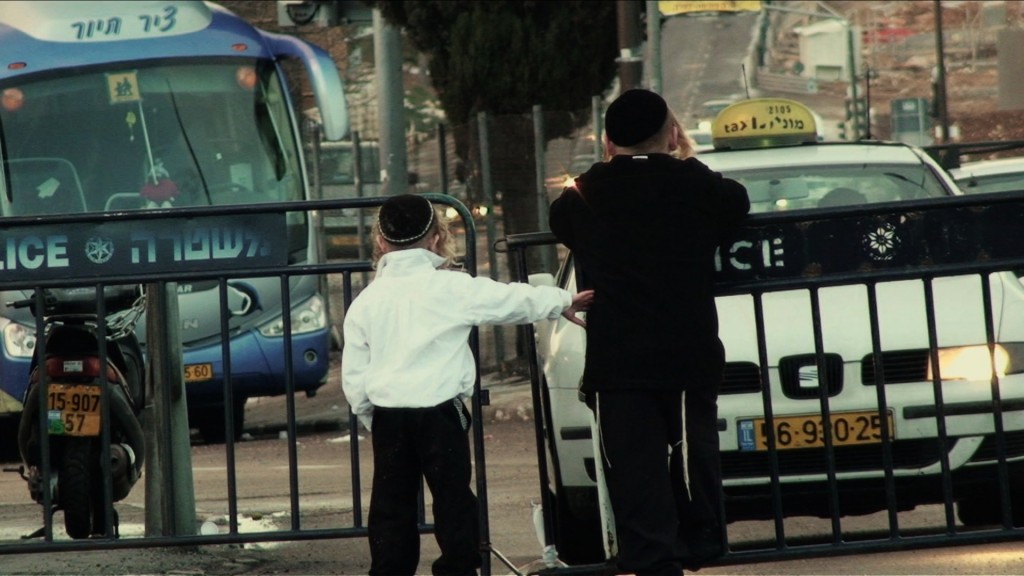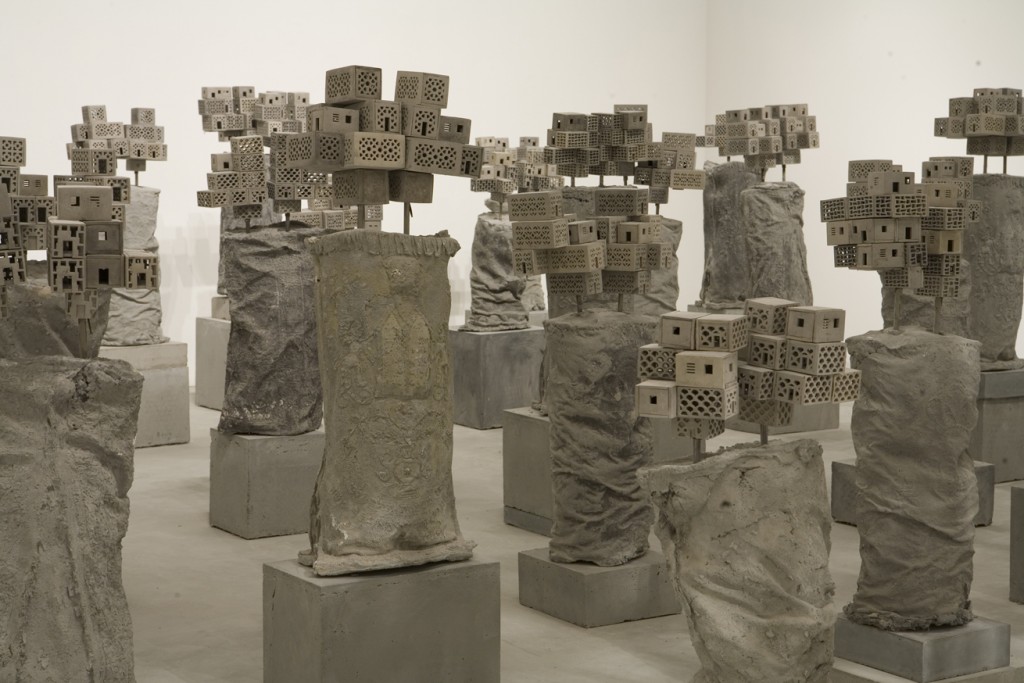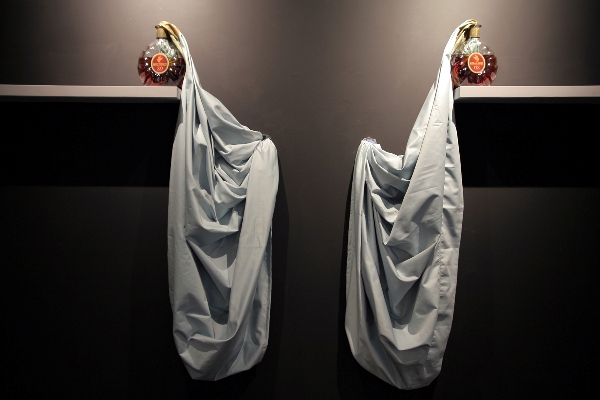The three artists short listed for the 2009 Gottesdiener Foundation Prize – Nira Pereg; Erez Israeli and Naama Tsabar- have been awarded solo exhibitions at the Tel Aviv Museum. Whoever the winner, the fact that they have all reached this final round, is an acknowledgement of their past achievements.
All three artists consider contemporary life from unusual perspectives and share an interest in documenting rituals or ritualistic behavior.

Pereg, for instance, has already produced several video films recording the behavior of groups. Canicule (2004),the earliest in this series, documented the habits of flamingoes in a German zoo.
She comes closer to home with the two videos she is exhibiting here. Shabbat (2008) and Kept Alive (2010), both photographed in Jerusalem and illuminating unusual facets of the city’s life. For Shabbat, employing maximum zoom technology, she photographed a ritual that takes place before nightfall on Fridays. At the entrance to religious neighborhoods, religious youth assisted by very small children set up road blocks to bar the entry of vehicles. The manipulated sound track that Pereg introduces into these scenes is most effective. She has eliminated the usual noises of the city, so that an unearthly silence prevails. This is broken only by the sound of footsteps and the grating of metal barriers as the youngsters drag them into position.
Rituals of burial are the focus of Pereg’s second work where the imagery is displayed simultaneously on three video channels, as well as by color photographs. Taking her camera into the vast burial grounds of Har Hamenuchot (Hill of Repose), Pereg photographs this ‘home of the dead” in such a way that it assumes the characteristics of a desirable real estate property. She shows us rows of wooden plaques with the word ‘reserved’ scrawled on them; ‘gardeners’ weeding empty plots; and ‘builders,’ alias the non-Jewish workers, digging graves to a prescribed method or working. Pereg also interviews the foreman {the estate agent ?) who describes, among other things, the different types of burial available.
Once again, Pereg introduces her own sounds, in this case the harsh clang of a pickaxe striking stone. Like any regular film, her video ends with a list of credits, but the names given are those of the employees in the cemetery. Members of the Chevrah Kadisha (the Burial Society,) supervisors of the grounds, are nowhere to be seen.

Erez Israeli is showing Curing, a new and noteworthy installation. The impetus for this work came from the life experience of German performance artist and shaman Joseph Beuys (1921-1986). Volunteering for the Luftwaffe in 1941, Beuys’ plane was shot down on the Crimean front where he claimed to have been nursed back to health by Tartar tribesman. This potential catastrophe, which Beuys continually referred to, apparently inspired him after the war to set about healing Germany’s ‘ sick soul’.
In a famous ritualistic performance in 1965, Beuys walked around a gallery cradling a dead hare and explaining pictures to the lifeless animal ( even a dead hare, he said, preserves more powers of intuition than some human beings with their stubborn rationality).
In a reversal of roles, Israeli displays a stuffed hare holding the inert figure of a man-puppet, identifiable as Beuys by the substances smeared on his head, as well as the inclusion of other details such as the German’s ubiquitous walking stick, now tucked under the hare’s arm. On the wall alongside this exhibit, Israeli has hung a placard with the words: How to Explain Pictures to a Dead Beuys. His version, in which the hare has become the aggressor and Beuys the victim, can be interpreted in various ways. But it is clear that the status of Beuys, the self-styled savior of post war Germany, is being undermined. Israeli doesn’t want to ‘explain pictures’ to Beuys, but to make sure that he remembers again and again how his country behaved towards its Jews.

In the second part of the exhibition, Israeli has laid out a graveyard. Some 30 tombstones constructed from cement are sited on the floor, their forms cast from collapsing torah mantles. The addition of black paint to the cement gives the impression of objects which have been through fire. On top of these memorial stones Israeli has sited clusters of miniature houses. Their interiors are bare, but the tracery on some walls is identical to the ornamentation found on some of the older Tel Aviv balconies.
As in the past, Israeli is once again stressing the importance of memorial rituals. In the same way that a catastrophic experience changed Beuys’ life, Israeli seems to be saying, that the tragedies which have befallen the Jewish people, might perhaps be the spur for new beginnings. This is not a work to raise one spirits, but its messages, and the artist’s clever manipulation of an iconic image from European art, stay in the memory.
While there are ritualistic features to be found in Sweat, Naama Tsabar’s complex presentation (in particular, in the repetitive actions performed in her video film), the overall impression is of a room filled with objects and situations in a state of flux. In the darkened space, one first comes across ‘sound’ walls constructed from domestic loudspeakers, the strings attached to them having been transformed into musical instruments. Next, one notes bottles, filled with liquor, positioned at various angles on wooden shelves. Strips of linen plugging the mouths of these bottles, or completely encasing them like shrouds, make contact with the wood. By the process of osmosis, the liquid in the bottles gradually seeps out, altering the balance and stability of the whole exhibit, which will eventually collapse.

Finally, we follow the videoed antics of a rock band. The lead singer is the artist herself who, after some time, starts to smash her guitar to pieces. She doesn’t succeed, but the stage on which she and her fellow musicians are standing, falls to pieces. According to the catalog text ‘Sweat’ is meant to induce “a toxic sensation, seductive… redolent of night life, music, drinking and intimacy,” It doesn’t work for me.
The winner will be announced on 13th April. The finals judge is Catherine Grenier, Deputy Director, National Museum of Modern Art, Pompidou Center, Paris.
Tel Aviv Museum of Art, 27 Shaul Hamelech Boulevard.
ANGELA LEVINE





